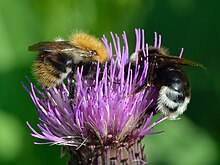Various-leaved thistle
| Various-leaved thistle | ||||||||||||
|---|---|---|---|---|---|---|---|---|---|---|---|---|

Various-leaved thistle ( Cirsium heterophyllum ) |
||||||||||||
| Systematics | ||||||||||||
|
||||||||||||
| Scientific name | ||||||||||||
| Cirsium heterophyllum | ||||||||||||
| ( L. ) Hill |
The various-leaved scrub thistle ( Cirsium heterophyllum ), also called alant thistle , is a species of plant that belongs to the subfamily of the Carduoideae within the family of the Asteraceae .
The use of the common name white dragon root is also documented for the Giant Mountains .
description
The different-leaved thistle is a perennial herbaceous plant that reaches heights of about 40 to 100 (rarely up to 150) centimeters. The whole plant is only very weakly prickly. Their upright, gray-felted, wingless stems , often overgrown with dark red, are mostly unbranched, at most with a few single-headed branches, and in the upper part they are conspicuously leafless.
The leaves are green on the top and felt-like snow-white on the underside and are stalked as basal leaves, on the stem they sit sessile and encompass the stem, but not run down. Their shape varies from undivided broadly lanceolate to more or less lobed to deeply pinnate, from which the German name of the species is derived. The also common name " Alant thistle " refers to a distant similarity of the undivided leaf variant as well as the overall habit of the different-leaved scraper thistle with the corresponding characteristics of the real alant ( Inula helenium ).
The numerous purple-red, rarely also white tubular flowers form about 3.5 to 5 centimeters long and thus quite stately flower heads, which are usually single, rarely in several at the stem ends. This is why this species is sometimes popularly known as the “shaving brush”. Before the single flowers unfold, the inflorescence can be tilted to one side. In connection with the so-called signature theory, the name “Melancholy thistle” is used in English-speaking countries for this species. When fully open, the inflorescences are, however, stiffly upright again.
The number of chromosomes is 2n = 34.
ecology
The various-leaved thistle is able to reproduce vegetatively and form dense groups through subterranean root runners. It is considered to be nutrient-demanding. Investigations have shown that the development or expression of the pinnate leaf shape depends heavily on the nutrient supply of the plant.
Locations and distribution
The various-leaved thistle grows preferentially in oozing wet to moist perennial corridors, fresh to moist mountain meadows and subalpine tall shrubbery. It occurs in societies of the associations Polygono-Trisetion, Calthion, Filipendulion, Adenostylion, Nardion, Caricion fuscae or Caricion ferrugineae. The main distribution area of the various-leaved spear thistle extends from the north of Great Britain over Northern and Eastern Europe to Siberia. Larger exclaves are located in the Caucasus, the Carpathians, Pyrenees, Alps and some German low mountain ranges, as well as isolated occurrences and the like. a. in Iceland and Greenland.
The main occurrences in Germany are the submontane to montane layers of the Erzgebirge, Vogtland, Thuringian Forest, Fichtelgebirge, Bohemian / Bavarian Forest and the Alps. Only Schleswig-Holstein had a significant number of lowland deposits, most of which were extinct before 1950.
In the Allgäu Alps, near the summit of the Roßkopf in Bavaria , it rises to 1810 m above sea level.
Systematics
Cirsium heterophyllum was 1753 Carl Linnaeus under the name Carduus heterophyllus in his work Species plantarum, Volume 2, page 824 first published . Hill recognized that it should be placed in the genus Cirsium and in 1768 gave it the name Cirsium heterophyllum, which is valid today . Synonyms for Cirsium heterophyllum (L.) Hill are Carduus helenioides auct. non L. , Carduus heterophyllus L. - Sp. Pl. , 1753, p. 824, Cirsium helenioides auct. non (L.) Hill .
literature
- Eckehart J. Jäger, Klaus Werner (ed.): Rothmaler, Exkursionsflora von Deutschland, Volume 4, Vascular Plants: Critical Volume . 9th edition. Spektrum Akademischer Verlag, Heidelberg 2002, ISBN 3-8274-0917-9
- Henning Haeupler , Thomas Muer: picture atlas of the fern and flowering plants of Germany (= the fern and flowering plants of Germany. Volume 2). Published by the Federal Agency for Nature Conservation. Ulmer, Stuttgart 2000, ISBN 3-8001-3364-4 .
Individual evidence
- ^ Georg August Pritzel , Carl Jessen : The German folk names of plants. New contribution to the German linguistic treasure. Philipp Cohen, Hannover 1882, page 101. ( online ).
- ↑ Northern Ireland's Priority Species & Species of Conservation Concern. Retrieved March 1, 2009 .
- ↑ a b Erich Oberdorfer : Plant-sociological excursion flora for Germany and neighboring areas . With the collaboration of Angelika Schwabe and Theo Müller. 8th, heavily revised and expanded edition. Eugen Ulmer, Stuttgart (Hohenheim) 2001, ISBN 3-8001-3131-5 , pp. 965 .
- ↑ Almut Weiskopf, Maria Romstöck, Albert Reif , Ernst-Detlef Schulze : Ecological investigations on the different-leaved Kratzdistel (Cirsium helenioides (L.) Hill) in Upper Franconia. Part II: heterophyllia and location . In: Tuexenia 8 (1988), pp 149-161 online. (PDF) Retrieved March 1, 2009 (PDF file, approx. 2 MB).
- ↑ Den virtuella floran. Retrieved on March 1, 2009 (area map of the northern hemisphere).
- ↑ Floraweb. Retrieved on March 1, 2009 (distribution map Germany).
- ↑ Erhard Dörr, Wolfgang Lippert : Flora of the Allgäu and its surroundings. Volume 2, IHW, Eching 2004, ISBN 3-930167-61-1 , p. 642.
- ↑ - Info on taxonomy at FloraWeb .
Web links
- Information on the different-leaved thistle on Floraweb.de
- Various-leaved thistle . In: BiolFlor, the database of biological-ecological characteristics of the flora of Germany.
- Profile and distribution map for Bavaria . In: Botanical Information Hub of Bavaria .
- Cirsium helenioides (L.) Hill In: Info Flora , the national data and information center for Swiss flora . Retrieved June 17, 2016.
- Thomas Meyer: Thistle data sheet with identification key and photos at Flora-de: Flora von Deutschland (old name of the website: Flowers in Swabia )


